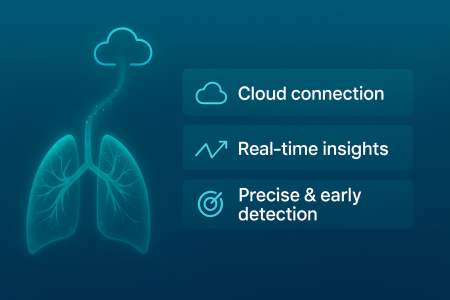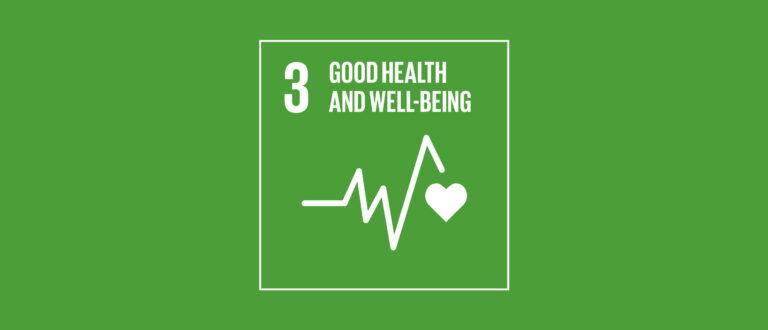Our Technology:
Breathe Smarter. Detect Earlier. Live Better.
Our Technology: Breathe Smarter. Detect Earlier. Live Better.
The Challenge: COPD and Smoking: A Dual Burden
Chronic Obstructive Pulmonary Disease (COPD) represents a critical global health challenge and is currently the third leading cause of death worldwide. In 2019, an estimated 392 million individuals were living with COPD, contributing to more than 3.5 million deaths annually and 74.4 million disability-adjusted life years (DALYs) lost [1, 2, 3, 4]. Importantly, nearly 75% of all COPD cases occur in low- and middle-income countries, where access to early diagnosis and effective management remains limited. Tobacco smoking accounts for over 70% of COPD cases in high-income countries [5]. This underscores the urgent need for innovative diagnostic and therapeutic solutions to address the growing disease burden worldwide [6].
The economic burden of Chronic Obstructive Pulmonary Disease (COPD) is substantial, with global direct and indirect costs estimated in the billions annually, largely due to long-term treatment requirements and frequent hospitalizations. Exposure to cigarette smoke remains the leading risk factor, accelerating the progressive decline in lung function; however, the fact that not all smokers develop COPD highlights the heterogeneity of disease susceptibility. This makes early and precise detection not only challenging but also critically important for effective disease management and cost containment [7].
Current monitoring and diagnostics solutions, such as spirometry and patient history, are not sensitive enough to measure airflow limitation and often fail to capture the early biological impact of smoking. One of the significant markers, exhaled carbon monoxide (eCO), reflects both smoking exposure and severity [8] [9] [10]. However, existing analyzers lack the precision and reliability needed to make eCO a routine clinical tool, leaving a major gap in how COPD is diagnosed and monitored.
COPD Today: Early Detection Relies on Incomplete Methods
COPD severity is classified using the GOLD criteria, which range from mild (Stage I) to very severe (Stage IV) based on post-bronchodilator FEV₁ % predicted values [11] [12]. While this framework guides treatment decisions, patients often remain undiagnosed until later stages due to incomplete diagnosis methods. For healthcare professionals, determining a patient’s GOLD stage requires careful interpretation of spirometry results and a thorough review of their medical history, which can be time-consuming and stressful, particularly in busy clinical settings. Delayed diagnosis also leads to higher long-term treatment costs and increased hospitalization.
Spirometry: The Current Gold Standard
While spirometry remains the gold standard for COPD diagnosis, it only signals a probable occurrence when FEV₁/FVC falls below 0.7 [11] [12]. In primary care, inaccurate diagnoses are common, often resulting from suboptimal test quality due to insufficient patient effort or limited training of healthcare providers. Moreover, spirometry is more often combined with clinical judgment, symptom assessment, and exacerbation history for a complete diagnosis, making the process time-consuming and costly.
Symptom-Based Questionnaires:
Tools like the COPD Diagnostic Questionnaire (CDQ) and COPD Population Screener (COPD-PS) help identify at-risk individuals. They assess smoking history, chronic cough, sputum production, and breathlessness. While questionnaires are easy to administer, they cannot definitively diagnose COPD. Moreover, the patients may underreport symptoms due to recall bias or embarrassment. For clinicians, interpreting scores adds administrative burden without guaranteeing early detection. Consequently, many early-stage patients remain undetected, leading to progressive disease and higher societal costs.
The Missing Indicators for Smoking History:
Smoking also drives airway inflammation, measurable via exhaled carbon monoxide (eCO) [8] [9] [10]. Studies indicate that exhaled carbon monoxide (eCO) levels tend to correlate with COPD severity and GOLD stages, suggesting their potential utility as a non-invasive biomarker for early detection. Exhaled carbon monoxide (eCO) concentrations (ppm) differ between COPD and non-COPD populations, with smokers with COPD exhibiting levels of approximately 12.6 ppm, healthy smokers 9.7 ppm, ex-smokers with COPD 5.2 ppm, and healthy nonsmokers 1.5 ppm [13] [14] [15]. Higher eCO levels are associated with more severe airflow limitations, yet eCO measurement is rarely integrated into routine practice, leaving a gap in early, cost-effective COPD detection.
The eCO measurement provides an immediate, objective, and non-invasive alternative in eliminating the need for lengthy questionnaires while giving clinicians a reliable tool for early risk classification. By replacing subjective reporting with measurable data, COPD detection becomes faster, more accurate, and ultimately more cost-effective.
Beyond Spirometry: Seeing the Full Picture of COPD
Our breakthrough breath analysis technology connects seamlessly to the cloud, delivering real-time insights straight to your mobile device bringing powerful, fully portable respiratory monitoring wherever you go. Unlike conventional respiratory assessment methods that overlook key biomarkers or provide inconsistent and low-sensitivity measurements, our platform technology addresses these gaps by analyzing critical exhaled breath biomarkers such as carbon monoxide, enabling more accurate and actionable insights into lung function.
Spiroluft combines precise breath sampling with integrated spirometry and respiratory rate monitoring, enabling reproducible detection of trace biomarkers for early identification of COPD and smoking-related conditions.

By integrating biomarker quantification with standard spirometry metrics including FEV₁, FVC, PEFR, FEF25-75 and respiratory rate, this approach generates a comprehensive dataset capturing both airway mechanics and biochemical indicators of disease. Such in-depth insight enhances early diagnosis, disease monitoring, and the development of personalized management strategies for respiratory and related systemic conditions.
Designed for scalability, the platform integrates data processing and wireless connectivity to seamlessly link with digital health ecosystems. This enables remote monitoring, longitudinal tracking, and precision care. By delivering actionable insights in real time, the technology can simplify diagnostics, enhance clinical outcomes, and reduce healthcare costs.

By improving the accuracy and accessibility of respiratory healthcare, the company contributes to the global effort to ensure well-being for all, in line with UN SDG 3.
[1] WHO, "Chronic obstructive pulmonary disease (COPD). Fact sheet.," WHO, Geneva, 2023.
[2] G. C. R. D. Collaborators., "Global, regional, and national deaths, prevalence, disability-adjusted life years, and risk factors for chronic respiratory diseases, 1990–2021: a systematic analysis for the Global Burden of Disease Study 2021," The Lancet Respiratory Medicine, p. 12(3):251–272., 2024.
[3] D. e. a. Adeloye, "Global, regional, and national prevalence of, and risk factors for, chronic obstructive pulmonary disease (COPD) in 2019: a systematic review and modelling analysis," The Lancet Respiratory Medicine, vol. 10, no. 5, pp. 447-458, 2022 May.
[4] S. Safiri, C.-C. K, N. M, N. SA and Sullman, "Burden of chronic obstructive pulmonary disease and its attributable risk factors in 204 countries and territories, 1990-2019:results from the Global Burden of Disease study 2019.," BMJ, vol. 378:e069679, 2022.
[5] T. a. c. o. p. d. (. W. t. k. summaries, "Tobacco and COPD," https://iris.who.int/bitstream/handle/10665/374026/9789240084452-eng.pdf, 2023 (accessed on 15September2025).
[6] "Chronic obstructive pulmonary disease (COPD). Key facts. In: World Health organization [website]," World Health Organization (https://www.who.int/news-room/fact-sheets/detail/chronic-obstructive-pulmonary-disease-(COPD), accessed 15September2025, Geneva, 2023.
[7] A. S. N. B. L. P. Çolak Y, "Characteristics and Prognosis of Never-Smokers and Smokers with Asthma in the Copenhagen General Population Study. A Prospective Cohort Study.," Am J Respir Crit Care Med., pp. 192(2):172-81, 2015 Jul.
[8] Tobacco Use and Dependence Guideline Panel, "Treating Tobacco Use and Dependence: 2008 Update.," US Department of Health and Human Services, Rockville (MD), 2008.
[9] NICE, "Tobacco: preventing uptake, promoting quitting and treating dependence, Guideline NG209,," National Institute for Health and Care Excellence,, London, 2025.
[10] U.S. Department of Health and Human Services, "Smoking Cessation: A Report of the Surgeon General.," U.S. Department of Health and Human Services, Centers for Disease Control and Prevention, National Center for Chronic Disease Prevention and Health Promotion, Office on Smoking and Health, Atlanta, GA, 2020.
[11] G. S. Committee, "Global Strategy for Prevention, Diagnosis and Management of COPD: 2023 Report," Global Initiative for Chronic Obstructive Lung Disease,, https://goldcopd.org/2023-gold-report/, 2023.
[12] V. J and et al, "Global Strategy for the Diagnosis, Management, and Prevention of Chronic Obstructive Pulmonary Disease: GOLD Executive Summary," Am J Respir Crit Care Med, p. 187(4):347–365., 2013.
[13] M. A. Ejazi, M. Shameem and e. al, "Correlation of exhaled carbon monoxide level with disease severity in chronic obstruction pulmonary disease," Lung India, vol. 35, no. 5, pp. 401-406, 2018.
[14] M. M. M. &. F. H. Gawad, "Role of exhaled carbon monoxide in assessment of chronic obstructive airway disease severity," Egypt J Bronchol, vol. 18, p. 41, 2024.
[15] D. O. B. I. Antus B, "Assessment of exhaled carbon monoxide in exacerbations of chronic obstructive pulmonary disease.," Physiol Int. , pp. 1;103(2):211-219, 2016 Jun.
Bibliography
[1] WHO, “Chronic obstructive pulmonary disease (COPD). Fact sheet.,” WHO, Geneva, 2023.
[2] G. C. R. D. Collaborators., “Global, regional, and national deaths, prevalence, disability-adjusted life years, and risk factors for chronic respiratory diseases, 1990–2021: a systematic analysis for the Global Burden of Disease Study 2021,” The Lancet Respiratory Medicine, p. 12(3):251–272., 2024.
[3] D. e. a. Adeloye, “Global, regional, and national prevalence of, and risk factors for, chronic obstructive pulmonary disease (COPD) in 2019: a systematic review and modelling analysis,” The Lancet Respiratory Medicine, vol. 10, no. 5, pp. 447-458, 2022 May.
[4] S. Safiri, C.-C. K, N. M, N. SA and Sullman, “Burden of chronic obstructive pulmonary disease and its attributable risk factors in 204 countries and territories, 1990-2019:results from the Global Burden of Disease study 2019.,” BMJ, vol. 378:e069679, 2022.
[5] T. a. c. o. p. d. (. W. t. k. summaries, “Tobacco and COPD,” https://iris.who.int/bitstream/handle/10665/374026/9789240084452-eng.pdf, 2023 (accessed on 15September2025).
[6] “Chronic obstructive pulmonary disease (COPD). Key facts. In: World Health organization [website],” World Health Organization (https://www.who.int/news-room/fact-sheets/detail/chronic-obstructive-pulmonary-disease-(COPD), accessed 15September2025, Geneva, 2023.
[7] A. S. N. B. L. P. Çolak Y, “Characteristics and Prognosis of Never-Smokers and Smokers with Asthma in the Copenhagen General Population Study. A Prospective Cohort Study.,” Am J Respir Crit Care Med., pp. 192(2):172-81, 2015 Jul.
[8] Tobacco Use and Dependence Guideline Panel, “Treating Tobacco Use and Dependence: 2008 Update.,” US Department of Health and Human Services, Rockville (MD), 2008.
[9] NICE, “Tobacco: preventing uptake, promoting quitting and treating dependence, Guideline NG209,,” National Institute for Health and Care Excellence,, London, 2025.
[10] U.S. Department of Health and Human Services, “Smoking Cessation: A Report of the Surgeon General.,” U.S. Department of Health and Human Services, Centers for Disease Control and Prevention, National Center for Chronic Disease Prevention and Health Promotion, Office on Smoking and Health, Atlanta, GA, 2020.
[11] G. S. Committee, “Global Strategy for Prevention, Diagnosis and Management of COPD: 2023 Report,” Global Initiative for Chronic Obstructive Lung Disease,, https://goldcopd.org/2023-gold-report/, 2023.
[12] V. J and et al, “Global Strategy for the Diagnosis, Management, and Prevention of Chronic Obstructive Pulmonary Disease: GOLD Executive Summary,” Am J Respir Crit Care Med, p. 187(4):347–365., 2013.
[13] M. A. Ejazi, M. Shameem and e. al, “Correlation of exhaled carbon monoxide level with disease severity in chronic obstruction pulmonary disease,” Lung India, vol. 35, no. 5, pp. 401-406, 2018.
[14] M. M. M. &. F. H. Gawad, “Role of exhaled carbon monoxide in assessment of chronic obstructive airway disease severity,” Egypt J Bronchol, vol. 18, p. 41, 2024.
[15] D. O. B. I. Antus B, “Assessment of exhaled carbon monoxide in exacerbations of chronic obstructive pulmonary disease.,” Physiol Int. , pp. 1;103(2):211-219, 2016 Jun.
